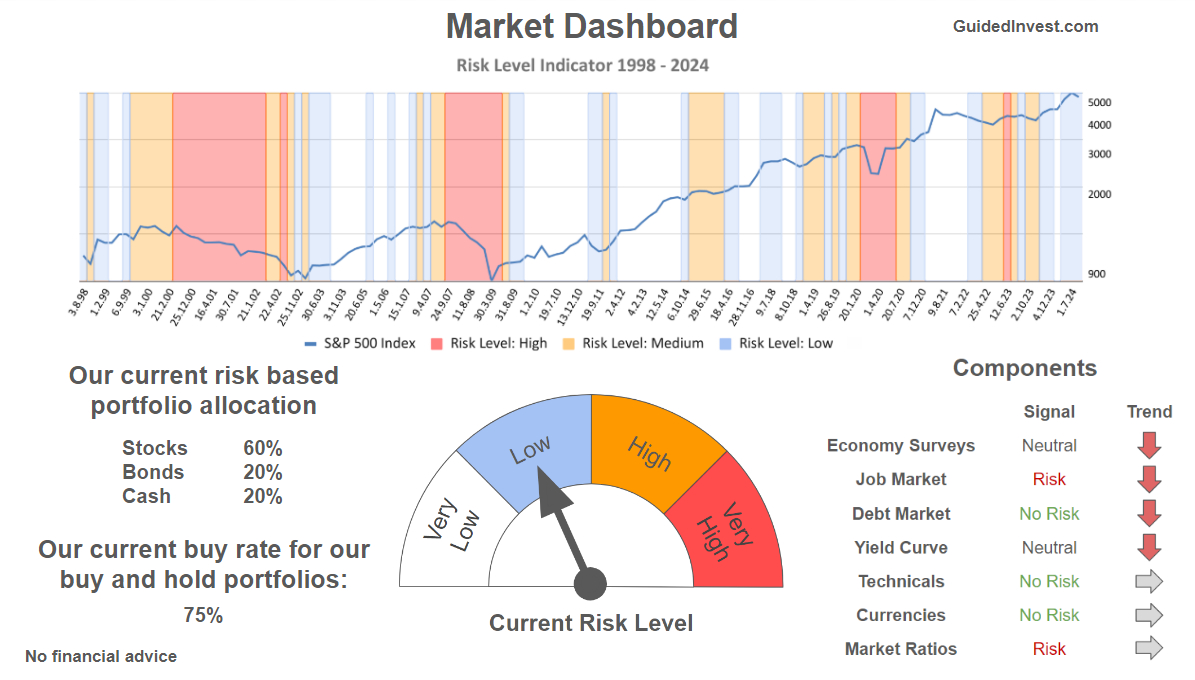Welcome to this week’s edition of our newsletter, where we analyze the latest movements of the S&P 500 and share our outlook on the market. It’s been a challenging week for investors, as the S&P 500 faced a significant loss of 4.4%. However, since the low point in August, the index is still up by 5.9%. This week, the S&P 500 experienced a particularly weak performance, starting with a sharp drop of 2.2% on Tuesday this downturn was likely triggered by weaker-than-expected manufacturing PMI data from the Institute for Supply Management (ISM), which hinted at slowing economic activity. Wednesday and Thursday saw minor fluctuations, but Friday brought another significant drop, which may have been driven by the disappointing non-farm payroll report, adding to concerns about the economy’s health.

Our last position, which we placed on August 8th, has been active until September 5th, when we sold it for a gain of 7,7%
Sie fragen sich, wann Sie als Investor den S&P 500 kaufen sollten? Entdecken Sie unsere maßgeschneiderten Dienstleistungen und schließen Sie sich unserer wachsenden Gemeinschaft von Do-it-yourself-Investoren an, die sich mit unserer Anleitung erfolgreich auf dem Markt zurechtgefunden haben.
Premium Guide
Advanced Investing Signals
139€ / Monat
Basic Guide
Basic Investing
Signals
49€ / Monat
Simple Guide
Selected
Signals
Kostenfrei
Congratulations! You’ve discovered your new free financial guide. Simply sign up for our most popular service, our Simple Guide.
In the last few weeks, we have closely monitored the S&P 500’s behavior around key support and resistance zones. The support zone, marked in green on our charts, and the resistance zone, marked in red, have been critical in guiding recent market movements. The S&P 500 has been fluctuating between these zones, bouncing up to resistance and down to support. However, on Tuesday, the index broke below the support zone, which then turned into a new resistance level. Both Wednesday and Thursday saw attempts to climb back into the green support zone, but these efforts were rejected, leading to further downward movement and another sharp drop on Friday. Currently, the S&P 500 appears oversold on shorter time frames and is right at the 100-day moving average, a level where a technical bounce is often expected. After the steep declines this week, further downside movement next week seems less likely, and a rebound could be on the horizon in the early days of next week. However, the bigger question remains whether this recent correction is over or if there is still room for deeper declines. Could we see a continuation to new all-time highs, or might the market plunge further, possibly testing levels lower than those seen at the start of August? Much will depend on whether the index sets new lows after the anticipated bounce. If new lows are reached, we could see a deeper downturn, potentially retesting the August low. It’s also noteworthy that significant stocks like NVIDIA, which make up a large portion of the S&P 500, are currently approaching their support levels. This could suggest a potential bounce, providing a hint that the broader market may also move upward from here. For subscribers it is very important to follow our risk management measures that we provide with all our services to protect against losses in case support zones break

Die nächsten Monate
The chart shows the typical seasonality for the S&P 500 during an election year, indicating patterns of market behavior around key months. Historically, we see a tendency for market weakness in May, June, and July, followed by a period of strong price gains up to early September. However, this is usually succeeded by a larger correction leading up to the election at the beginning of November. The period from mid-June to the end of July is characterized by some market softness, with only modest upward movement, which aligns with the recent declines we’ve witnessed. As we move into September, which is historically the weakest month of the year, we may continue to see this pattern of volatility. Given the historical data, there could be further weakness until the U.S. election on November 5th. However, it’s important to interpret this seasonality with caution, especially this year, as we have already experienced a significant rise in prices. Investors should consider both seasonality trends and our analysis for a balanced view. Proper risk management is essential in navigating these market conditions.

Unser Markt-Dashboard bietet einen schnellen Überblick über die aktuellen Marktbedingungen und, was noch wichtiger ist, das damit verbundene Risiko. Unten sehen sie ein Chart eines unserer Tools, des Risiko-Level-Indikators. Es zeigt das prognostizierte Risiko von 1998 bis 2024. Wenn Sie interessiert sind, können Sie hier unsere Dashboard-Seite besuchen..

Die Welt der Finanzen ist komplex und umfasst viele Fachbegriffe. Für die Erklärung dieser Begriffe empfehle ich das Lexikon von Investopedia. Investopedia dictionary.

Schreibe einen Kommentar